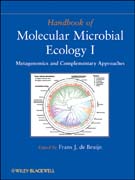
Handbook of molecular microbial ecology I metagenomics and complementary approaches
Bruijn, Frans J. de
ÍNDICE: Preface. Contributors. 1. Introduction (Frans J. de Bruijn). Background Chapters. 2. DNA reassociation yields broad-scale information on metagenome complexity and microbial diversity (V. Torsvik). 3. Diversity of 23S rRNA genes within individual prokaryotic genomes (Zhiheng Pei). 4. Use of the rRNA operon and genomic repetitive sequences for the identification of bacteria (A. Nascimento). 5. Use of different PCR primer-based strategies for characterization of natural microbial communities (James Prosser). 6. Horizontal gene transfer and recombination shape mesorhizobial populations in the gene center of the host plants Astragalus luteolus and Astragalus ernestii in Sichuan, China (Xiaoping Zhang). 7. Amplified rDNA restriction analysis (ARDRA)for identification and phylogenetic placement of 16S-rDNA clones (Menachim Sklarz). 8. Clustering-based peak alignment algorithm for objective and quantitative analysis of DNA fingerprinting data (Satoshi Ishii). The Species Concept. 9. Population genomics informs our understanding of the bacterial species concept (Margaret Riley). 10. Genome analysis of Streptococcus agalactiae: Implication for the microbial pan-genome (R. Rappuoli). 11. Metagenomic insights into bacterial species (Kostas Konstantinidis). 12. Report of the ad hoc committee for the re-evaluation of the species definition in bacteriology (E. Stackebrandt). 13. Metagenomic Approaches for the Identification of Microbial Species (David Ward). Metagenomics. 14. Microbial Ecology in the age of metagenomics (Jianping Xu). 15.The enduring legacy of small rRNA in microbiology (Susan Tringe). 16. Pitfalls of PCR-based rRNA gene sequence analysis: an update on some parameters (Stackebrandt). 17. Empirical testing of 16S rRNA gene PCR primer pairs reveals variance in target specificity and efficacy not suggested by in silico analysis (Sergio Morales and Bill Holben). 18. The impact of next-generation sequencingtechnologies on (meta)genomics (George Weinstock). 19. Accuracy and quality of massively parallel DNA pyrosequencing (Susan Huse and David Mark Welch). 20.Environmental shotgun sequencing: Its potential and challenges for studying the hidden world of microbes (Jonathan Eisen). 21. Comparison of random sequence reads versus 16S rDNA sequences for estimating the biodiversity of a metagenomic library (C. Manischan). 22. Metagenomic libraries for functional screeing(Svein Valla). 23. GC Fractionation Allows Comparative Total Microbial Community Analysis, Enhances Diversity Assessment, and Facilitates of Minority Populations of Bacteria (Bill Holben). 24. Enriching plant microbiota for a metagenomic library construction (Ying Zeng). 25. Towards Automated Phylogenomic Inference (Wu and Eisen). 26. Integron first gene cassettes: a target to find adaptive genes in metagenomes (Christine Cagnon). 27. High-resolution metagenomics: assessing specific functional types in complex microbial co
- ISBN: 978-0-470-64479-9
- Editorial: John Wiley & Sons
- Encuadernacion: Rústica
- Páginas: 784
- Fecha Publicación: 24/06/2011
- Nº Volúmenes: 1
- Idioma: Inglés
